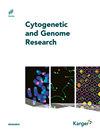Meiotic Segregation of an Isodicentric Derived from Chromosome 15 in Sperm of a Patient with Mosaic Karyotype: Case Report and Review of the Literature
IF 1.7
4区 生物学
Q4 CELL BIOLOGY
引用次数: 0
Abstract
Small supernumerary marker chromosomes (sSMCs) are defined as structurally abnormal chromosomes that are difficult to identify by conventional cytogenetic techniques. sSMCs are 3.75 times more common in infertile men than in the general population. This study aimed at characterizing a supernumerary marker chromosome in a nonconsanguineous infertile couple and analyzing its meiotic segregation in sperm by multicolor FISH. The male partner’s karyotype was mos 47,XY,+idic(15)(pter→q11.1::q11.1→pter)[6]/46,XY[24].ish idic(15)(NOR+,D15Z3+,SNRPN–,D15Z3+,NOR+). In triple FISH using CEP 15, BAC 15, and BAC 21 probes, 4,227 spermatozoa of the patient were analyzed, and the sSMC was detected in only 0.66% of spermatozoa. In triple FISH employing CEP X, CEP Y, and BAC 18 probes, 2,008 spermatozoa of the patient were analyzed. The frequency of disomic and diploid sperm was not significantly different from control donors. To our knowledge, segregation of an sSMC 15 has been reported in only 9 males with non-mosaic karyotypes. These studies described rates of spermatozoa with sSMC 15 ranging from 6.23% to more than 50%. In this work, we report the first meiotic segregation analysis of a chromosome 15-derived sSMC in spermatozoa of a patient with a mosaic karyotype. The low rate of spermatozoa with sSMC detected is concordant with the low proportion of abnormal cells in our patient’s lymphocytes. Moreover, the risk of interference of this sSMC with other chromosomes seems minimal. Genetic counseling was recommended given that the risk of chromosomal imbalance in the fetus linked to paternal sSMC was very low. Finally, a healthy boy was born after a natural pregnancy.马赛克核型患者精子中15号染色体等心核的减数分裂分离:病例报告和文献复习
小的超多标记染色体(sMCs)被定义为结构异常的染色体,难以通过传统的细胞遗传学技术进行鉴定。SMCs在不育男性中的常见率是普通人群的3.75倍。本研究旨在通过多色FISH技术对一对非血缘不育夫妇的多个标记染色体进行表征,并分析其在精子中的减数分裂分离。男性伴侣的核型为mos 47,XY,+idic(15)(pter→q11.1::q11.1→pter)[6]/46,XY[24].ish idic(15)(NOR+,D15Z3+,SNRPN-,D15Z3+,NOR+)。在使用CEP 15、BAC 15和BAC 21探针的三重FISH中,分析了患者的4227个精子,并且仅在0.66%的精子中检测到sSMC。在使用CEP X、CEP Y和BAC 18探针的三重FISH中,分析了患者的2008个精子。二精子和二倍体精子的频率与对照供体没有显著差异。据我们所知,只有9例具有非镶嵌核型的雄性被报道分离了一个sSMC 15。这些研究描述了sSMC 15的精子发生率为6.23%至50%以上。在这项工作中,我们报道了第一次对镶嵌核型患者精子中源自15号染色体的sSMC的减数分裂分离分析。sSMC精子检出率低与患者淋巴细胞中异常细胞比例低相一致。此外,这种sSMC干扰其他染色体的风险似乎很小。鉴于与父亲sSMC相关的胎儿染色体失衡的风险非常低,建议进行遗传咨询。最后,一个健康的男孩在自然怀孕后出生了。
本文章由计算机程序翻译,如有差异,请以英文原文为准。
求助全文
约1分钟内获得全文
求助全文
来源期刊

Cytogenetic and Genome Research
生物-细胞生物学
CiteScore
3.10
自引率
5.90%
发文量
25
审稿时长
1 months
期刊介绍:
During the last decades, ''Cytogenetic and Genome Research'' has been the leading forum for original reports and reviews in human and animal cytogenetics, including molecular, clinical and comparative cytogenetics. In recent years, most of its papers have centered on genome research, including gene cloning and sequencing, gene mapping, gene regulation and expression, cancer genetics, comparative genetics, gene linkage and related areas. The journal also publishes key papers on chromosome aberrations in somatic, meiotic and malignant cells. Its scope has expanded to include studies on invertebrate and plant cytogenetics and genomics. Also featured are the vast majority of the reports of the International Workshops on Human Chromosome Mapping, the reports of international human and animal chromosome nomenclature committees, and proceedings of the American and European cytogenetic conferences and other events. In addition to regular issues, the journal has been publishing since 2002 a series of topical issues on a broad variety of themes from cytogenetic and genome research.
 求助内容:
求助内容: 应助结果提醒方式:
应助结果提醒方式:


